CHAPTER VI - Mesic Woods
Eventually, the path begins to dip downward. Here the water table is a
little higher and we begin to see trees that enjoy having a more
constant supply of water. One such is the Blackjack Oak, Quercus
marilandica.
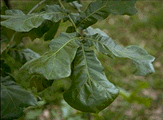
The leaves of Blackjack Oak are large, narrow at the base, and with
three shallow lobes at the tip. Like Post Oaks, Blackjacks tend to have
irregular canopies and crooked branches, but they never grow as large
as Post Oaks.
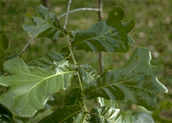
Another tree that likes moist conditions is the Honey Locust, Gleditsia
triacanthos. Large, branched thorns grow from the trunk and
branches, making it something of a hazard in the home landscape. The
fruits are flat, black, and banana-
shaped. The pulp around the seeds is sweet, so that the fruits are
quickly torn apart and eaten by animals after they fall.
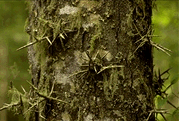
Lick Creek Park is home to many woodland wildflowers. This is Lyre-leaf
Sage, a member of the mint family (Salvia lyrata). It is quite
common in our area and in some years puts on quite a show. It is not a
fussy plant, equally at home in the woods as in a vacant lot or
someone's front yard.
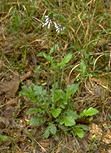
Daisy Fleabane, (Erigeron sp.) has daisy-like heads with many
narrow white rays. The local species are very difficult to tell apart.
Some people call these Marguerites.
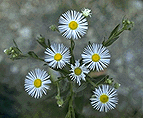
White Penstemon (Penstemon laxiflorus or australis,
depending on whom you ask...) is an unexpected treat in late spring. A
modified fifth stamen makes a bearded yellow "tongue" poking out of the
flower, hence its other common name--
Beardtongue.
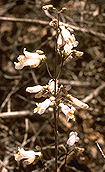
Because this is Texas and the woods are drier than those "back east,"
we have some plants that some people would never associate with the
forest. Prickly Pear Cactus, Opuntia lindheimeri?, is one of
these. All it asks for is well-drained, sandy soil and an opening in
the canopy to provide sunlight.
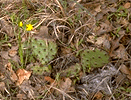
The flowers of Prickly Pear are often a rich, bright yellow, though
some can be maroon or wine-colored. This is probably O. lindheimeri.
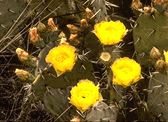
In sharp contrast to cacti, Lick Creek Park is also home to some plants
more typical of boggy areas. In moss cushions along the path are
Sundews, Drosera annua. Using droplets of sticky fluid, these
little plants (each about as broad as a dime or penny) trap insects and
digest them. This supplements their nitrogen intake. One of the
drainages in the park is called Sundew Creek.
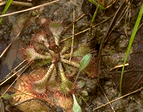
The park is also home to several species of orchid. Spiranthes
parksii, the Navasota Ladies' Tresses, is found in only a few
counties in Texas and is on the endangered species list. Part of the
reason the park was established was to set aside habitat for this
plant. October and November are the only months you'll see them in
flower.

This is Spiranthes cernua, a close relative of the Navasota
Ladies' Tresses. It is a fall bloomer too, and can be found in the same
type of habitat--Post Oak Woods along natural drainages and woodland
paths. Both are fairly inconspicuous even in flowering time--a single
stalk to about 1 foot high with white to cream or slightly greenish
flowers.

Telling the two apart requires practice and careful field
observation because you may also encounter forms that appear somewhat
intermediate like this example of Spiranthes cernua.
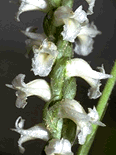
Ladies' Tresses flowers appear without leaves. The leaves come up in
the spring to make food for the plant. They wither and disappear long
before fall. It is common for many temperate orchids to produce leaves
and flowers at different times.
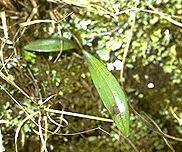
There are spring-and summer-flowering species of Spiranthes
too. This is Spiranthes vernalis, which puts in an appearance
in the spring. No confusing this one with the S. parksii!

Occasionally we spot other orchids in the park. Grass Pink, Calopogon
oklahomensis, is rare along Sundew Creek. Until recently, this
plant was thought to be C. tuberosus, but it is in fact a
separate species.

At this point in the trip, we have begun crossing small drainages,
moving slightly downhill all the time. Water Oak (Quercus nigra)
begins to be part of the canopy. These are large trees with a more
rounded, regular canopy and straighter branches than the Post or
Blackjack Oak. The trunks often have horizontal bands of white lichen.
These stripes make the tree recognizable even in the leafless state.
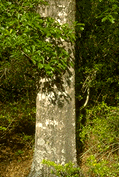
Water oak leaves are usually somewhat spatulate: narrow at the base,
broader at the tip, and smaller than Post Oak or Blackjack leaves.
Leaves of young plants or of water sprouts, however, may have all sorts
of different shapes, many with teeth or lobes. New leaves in spring are
a bright, "poisonous" acid green.
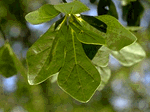
Chapter 7 - Epiphytes and Vines
Lick Creek Park Field Trip Home Page